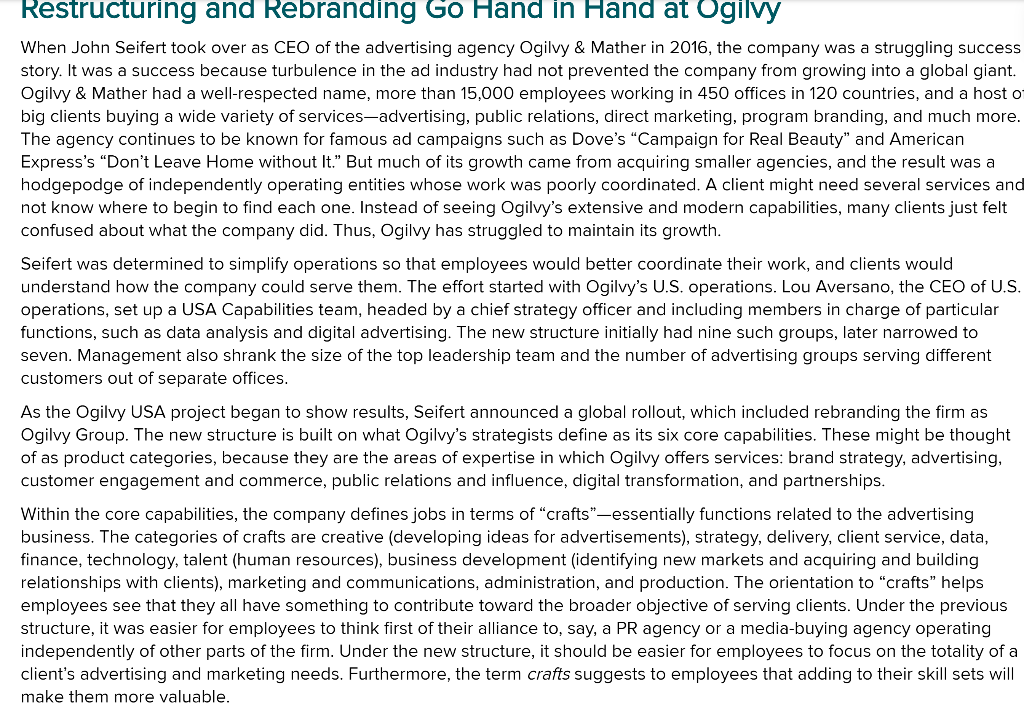Restructuring and Rebranding Go Hand in Hand at Ogilvy
Restructuring and Rebranding (50 Hand in Hand at Ogilvy When John Seifert took over as CEO of the advertising agency Ogilvy & Mather in 2016, the company was a struggling success story. It was a success because turbulence in the ad industry had not prevented the company from growing into a global giant. Ogilvy & Mather had a wellrespected name. more than 15,000 employees working in 450 offices in 120 countries, and a host 0' big clients buying a wide variety of servicesadvertising, public relations, direct marketing, program branding, and much more. The agency continues to be known for famous ad campaigns such as Dove's \"Campaign for Real Beauty" and American Express's \"Don't Leave Home without It." But much of its growth came from acquiring smaller agencies. and the result was a hodgepodge of independently operating entities whose work was poorly coordinated. A client might need several services and not know where to begin to nd each one. Instead of seeing Ogilvy's extensive and modern capabilities, many clientsjust felt confused about what the company did. Thus, Ogilvy has struggled to maintain its growth. Seifert was determined to simplify operations so that employees would better coordinate their work, and clients would understand how the company could serve them. The effort started with Ogilvy's US. operations. Lou Aversano, the CEO of US. operations, set up a USA Capabilities team, headed by a chief strategy officer and including members in charge of particular functions, such as data analysis and digital advertising. The new structure initially had nine such groups, later narrowed to seven. Management also shrank the size ofthe top leadership team and the number of advertising groups serving different customers out of separate offices. As the Ogilvy USA project began to show results. Seifert announced a global rollout, which included rebranding the firm as Ogilvy Group. The new structure is built on what Ogilvy's strategists define as its six core capabilities. These might be thought of as product categories, because they are the areas of expertise in which Ogilvy offers services: brand strategy, advertising, customer engagement and commerce, public relations and inuence, digital transformation. and partnerships. Within the core capabilities, the company definesjobs in terms of "crafts"essentia|ly functions related to the advertising business. The categories of crafts are creative (developing ideas for advertisements}, strategy. delivery, client service. data, finance, technology, talent (human rescurces), business development [identifying new markets and acquiring and building relationships with clients}, marketing and communications, administration, and production. The orientation to \"crafts\" helps employees see that they all have something to contribute toward the broader objective of serving clients. Under the previous structure. it was easier for employees to think first of their alliance to, say, a PR agency or a mediabuying agency operating independently of other parts of the firm. Under the new structure, it should be easier for employees to focus on the totality ofa client's advertising and marketing needs. Furthermore. the term crafts suggests to employees that adding to their skill sets will make them more valuable. An important objective ofthe restructuring was to promote coordination and efficiencyacting as a kind of global partnership. rather than a set ofindependent offices. Beginning with the Ogilvy USA strategy. management began to shift away from offices being financially independent of one another. Instead, groups measure their financial performance on a shared statement. Managers who had prided themselves on independence had to shift to seeing the offices united in serving clients and carrying out Ogilvy's mission of \"making brands matter.\" That way, if clients in, say, the Chicago office need a service best provided by the Atlanta office, managers have an incentive to coordinate their work to meet the client's needs. To enable the coordination, Ogilvy added information technology: the Connect software platform, which makes it easy for employees at any of its locations to share and look up knowledge online. With Connect, employees also can link to training modules and coworkers throughout the organization. Increased coordination is notjust an end, but also a means to help the organization respond faster when a customer need arises. The smoother operations should reduce expenses. But more than that, CEO Seifert hopes this reorganization will help existing and potential clients understand what Ogilvy isa brand representing an agency that offers, above all, creativity. Questions for Discussion 1. How well does Ogilvy's restructuring fit the principles of the contingency theory of organizational design? Explain. 2. Where do you see examples of a functional structure and a divisional structure in the redesigned version of Ogilvy? 3. What was Ogilvy's approach to coordinating functions and divisions in its restructured organization? What other methods of coordination might it use








